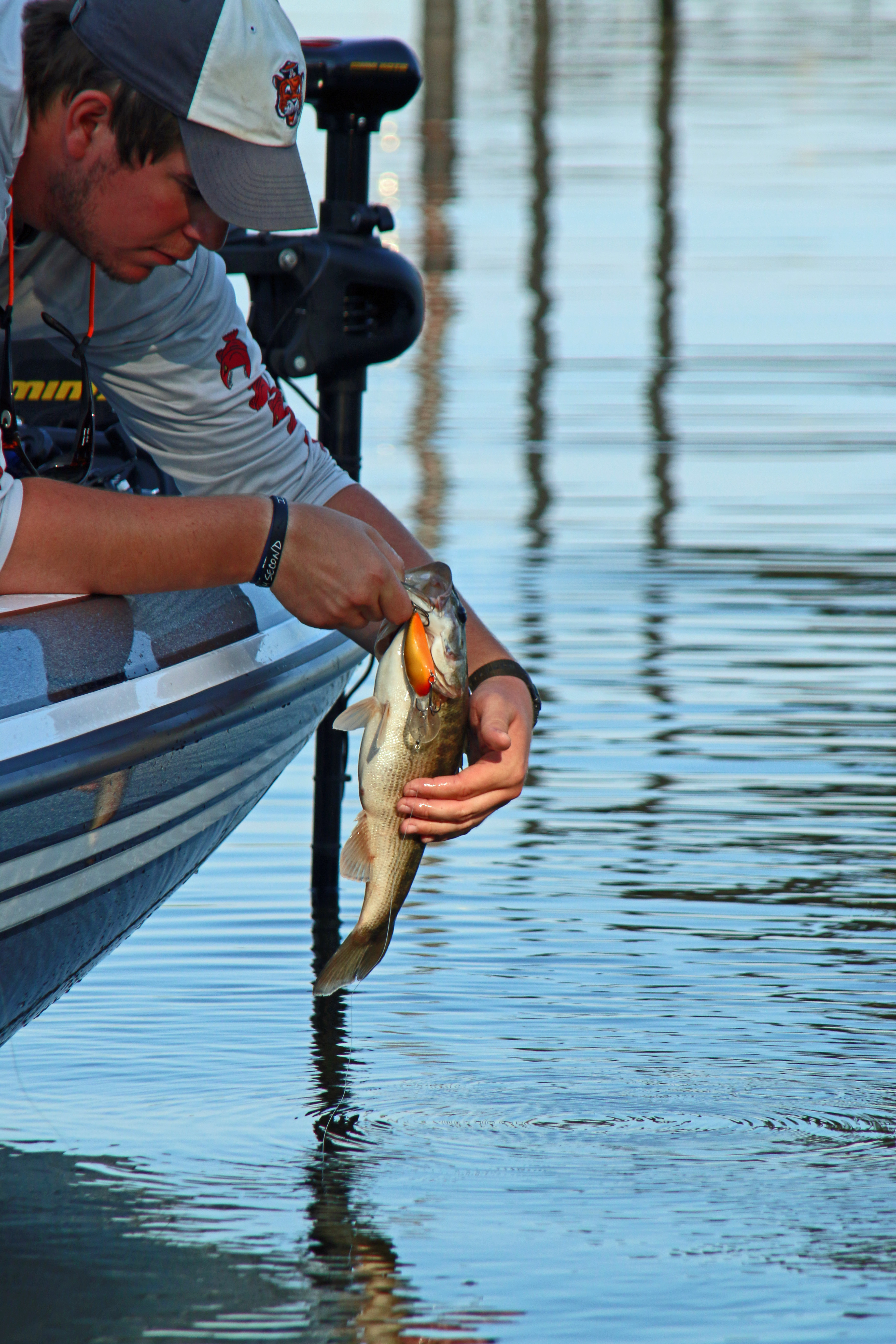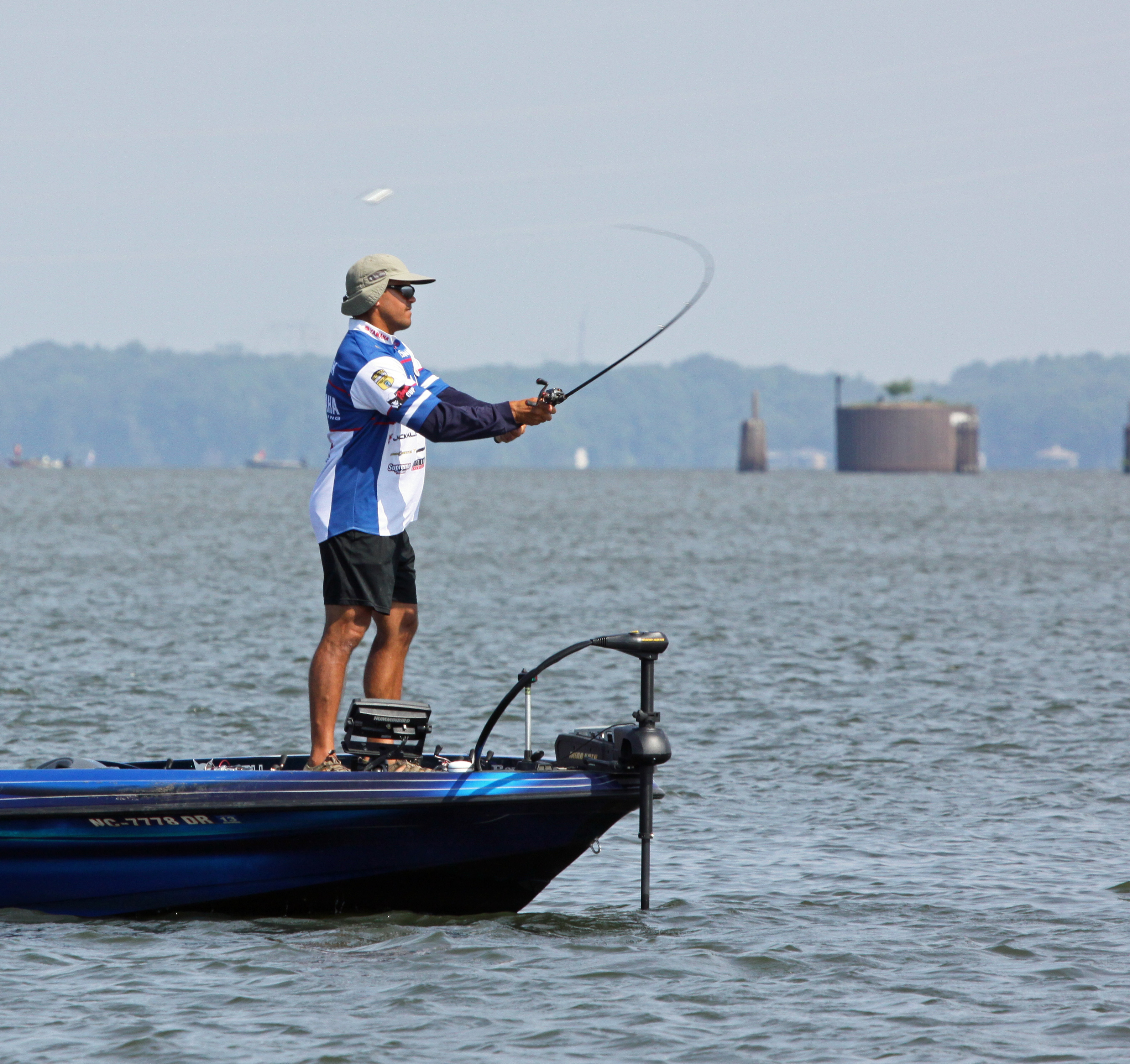During the summer months, bass retreat to the cooler depths in lakes and rivers across the Cotton State. Creek channels and river ledges become the favorite hideouts of bass seeking a reprieve from the sweltering southern sun. Although some bass will move shallow to feed, most of their summer is lounging in deeper pools. This means that late summer bass fishing, as the temperatures rise, is most successful in deep water.
Modern technology in the form of GPS and fish locating electronics have helped summer bass anglers locate hot locations. Down-scan, HDI, and side-scan imaging have simplified the search for homes of summer bass. But, finding the fish is only half the battle.
Most novice anglers think any bottom bumping lure will produce on a late summer bass fishing trip.While some deep water bass will strike at any offering, wise anglers will need to employ certain lures and techniques to catch them consistently during the summer months.
Locales for Deep Bass
On most lakes, bass holding in deep water will tend to hang out around some type of cover. Stumps, brushtops and big rocks are always top spots when late summer bass fishing. Depending on the lake, water flow and weather, summer bass may be found from around 12- to 20- plus feet deep.

A quality sonar unit will help locate structure and schools of deep summer bass.
On reservoirs and larger lakes where current may be present, look for bass in creeks and river channel swings. These areas can have wash-out areas where the current has cut away into the channel wall. On many lakes, river ledges that offer a contour break or hump are also prime targets for deep water bass.
“A sweet spot for summer bass in any lake is a hard bottom,” advises B.A.S.S. Elite pro, Mark Davis of Arkansas. “Gravel, rock or a shell bed are types of hard bottoms I look for in the summer.”
Davis mentions hard bottoms are critical in locating bass on older lakes. The older lakes and reservoirs have an accumulation of silt. Bass will naturally seek out the harder bottoms.
Brushtops can be a boon when late summer bass fishing. Many lakeside property owners will deposit discarded Christmas trees and brush in the lake depths for crappie. However, bass will also make these spots their summer hangout. Late-model sonar units can easily pick out a brush top situated on the lake bottom.
Deep Lure Choices
While there is a wide array of lure choices for deep water bass, only a few top selections are needed. Crankbaits are by far the first choice for most summer bass anglers. Carolina-Rigs and heavy spinnerbaits also work well for deep bass. Swimbaits have been around a while, but recently more anglers are giving these lures a shot at bass in the depths.

Heavy-weight spinnerbaits can reach down deep to summer bass hideouts.
Depending on the brand and manufacturer, crankbaits are made from either wood or plastic. Both materials offer specific traits for various styles of cover and fishing. Most summer anglers carry both types in their tackle bag and will use a particular type on the lake cover and water depth.
“My choice for crankbaits is a Rapala DT series,” reports Donnie Sims of Lincoln, Ala. “I like a shad color with a little chartreuse mixed in. The DT 16 will dive to around 16 feet deep and fits most of my summer bass spots.”
On lakes where gizzard and threadfin shad are common, they will take on a chartreuse hue during the summer months.
Other top crankbait brands that offer deep-diving lures are Strike King in their XD series, Mann’s and Livingston. Tall offer a variety of colors, sizes, and depths.

Shad colors and variations can trigger strikes form lazy summer bass in deep waters.
Shad colored lures are popular for most lakes. And there is a variety of color options in shad patterns. But, when fishing around rocks and gravel bars a crawfish colored bait is a smart choice. Lures with some red or orange on the belly will simulate a crawfish scurrying across the bottom.
Many anglers may not associate spinnerbaits with deep water bass fishing. However, heavyweight blade baits are a good choice in getting down in the face of a bass. Spinnerbaits can be used wherever a crankbait can be used. Also, the spinnerbaits can remain in the strike zone longer.
Heavy spinnerbaits like the Ledgebuster brand are available in ¾-, 1- and 1 1/2- ounce sizes. The strike King Hack Attack Heavy Cover spinnerbait is available in 1/2-, 3/4- and 1-ounce. Both baits have large, heavy hooks.
In recent years the swimbait craze has entered the South. The lures have long been popular on the west coast. But, pro anglers use swimbaits in tournament waters all over the Southeast. B.A.S.S. Elite pro angler Steve Kennedy of Auburn, Ala. used a 6- inch swimbait to win an Elite Series event on West Point Lake in 2011.
“The swimbait is a great lure for catching larger bass,” Kennedy reports. “They work well in clear water and can be fished at a variety of depths.”
One advantage of swimbaits is that different weight heads and hook sizes can be used with the same soft-plastic body. While 6- inch size is popular 8- and 10- in models also perform well. Later in the summer months, the size of forage fish is larger.
Gear for Going Deep
Fishing large, heavy lures can be tiring for the best of summer anglers. That is why the proper gear is necessary to optimize on the potential of the lure and angler. No wimpy gear here.
“I prefer a heavy action rod around 7- feet long with a fast tip for crankbaits,” comments Sims. “This rod allows me to make long to get the crankbait down deep.”
A top-quality reel with a wide spool will hold more line and allow for longer casts. Reels by Quantum, ABU Garcia and Lew’s all offer baitcasting style reels for deep water bass. While the 5.3:1 gear ratio was a popular speed for crankbaits, faster reels in the 6.3:1 and even the 7.0:1 gear ratios are used for cranking deep lures.

Lighter weight line in the 12- to 14- pound-test class will allow large crankbaits to reach their maximum depths.
Line size and type can be critical when fishing deep water for bass. Braided or fluorocarbon is the selection for most pro anglers for deep swimbaits and spinnerbaits. Line size in the 20- to 50- pound class is common for these lures. However, line size and type make a difference with crankbaits.
“For deep cranking, I use a 12- to 20- pound test fluorocarbon line depending on the lure and structure that I’m fishing,” Davis advises. “The smaller diameter line the deeper the crankbait will run and not loose action.”
All the above lures can be fished in a similar fashion. Long casts are required to allow the lure to get down in the strike zone. This is especially true with crankbaits.

Long rods will increase casting distance to cover a larger section of water.
Davis and Sims both recommend making long cast past the intended target area. When the crank is retrieved, it should have reached its maximum depth at the spot where the fish are holding. Spinnerbaits and crankbaits can be counted down to the required depth before the retrieve is begun.
Anglers should allow the lure to come in contact with the bottom, brush or other structure. Crankbaits will kick up some dirt and make plenty of noise on the bottom imitating a crawfish and catching the attention of a bass.
Swimbaits and spinnerbaits can be fished with a steady retrieve or a stop-and-go action for a yo-yo type effect. Anglers will need to experiment with various retrieves to determine the mood of the fish for that day.

Vary the retrieve and casting angles to deep bass locations to determine what the fish prefer.
A critical point in late summer bass fishing is boat position in relation to the target area. Make repeated casts to the same locale from the same angle. If few or no strikes, re-position the boat 30- to 45- degrees and continue casting. Sometimes a slight change in the casting angle can trigger more strikes.
This article first appeared in the August 2018 print issue of Great Days Outdoors Magazine. For more great hunting and fishing content for the deep South, subscribe to Great Days Outdoors print and digital editions or click the image to download this issue.

